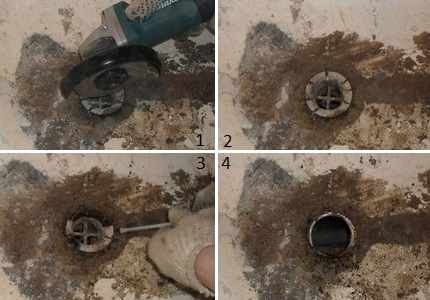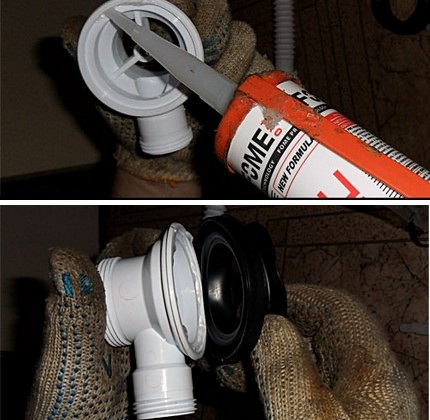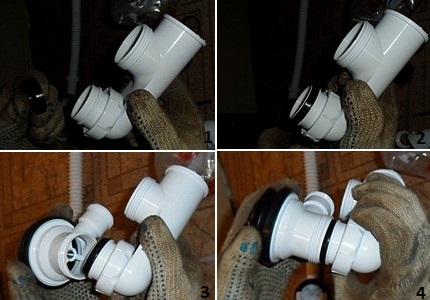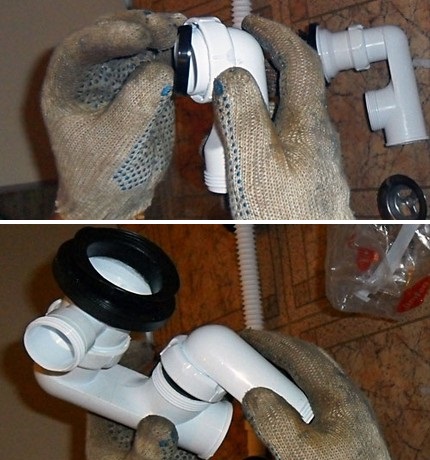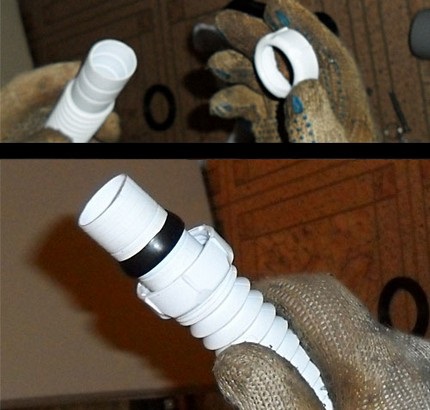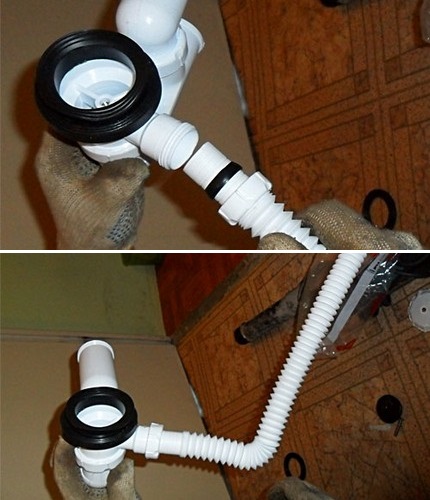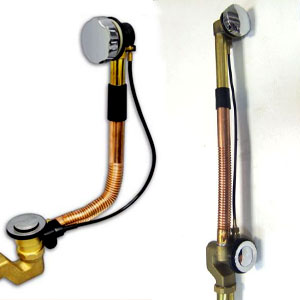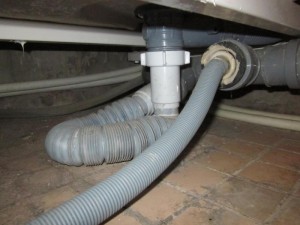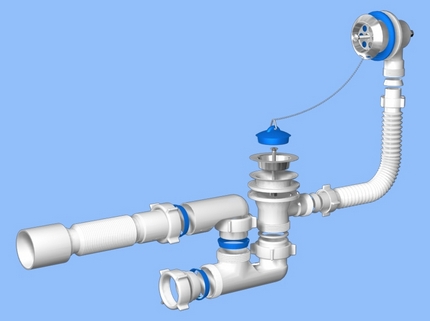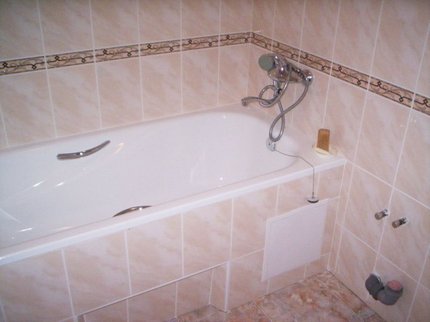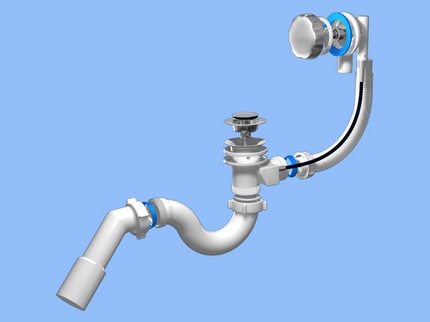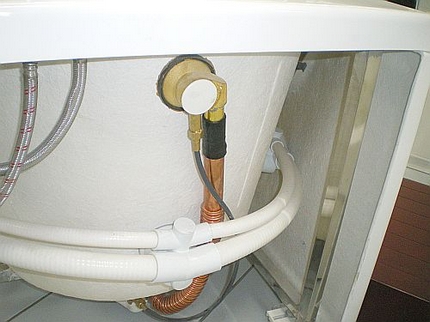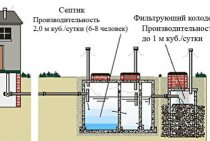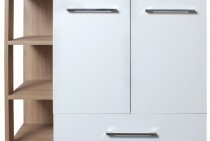How to install a tub piping without assistance
You can replace the drain-overflow device yourself by reading the step-by-step video instructions on our website. An exception is the metal strapping, for the correct installation of which it is better to involve professionals. Before proceeding with the installation of new plastic equipment, it is necessary to dismantle the old one, which will require:
thoroughly clean the surface of the bath;
if it is difficult to crawl under the bath, it should be turned over;
remove the siphon
remove dirt using special detergents;
Carefully detach the drain pipe and overflow grate.
Then you can proceed to the installation of the strapping. The drain and overflow neck are installed exactly the same, for which you must perform the following steps:
clean the neck from burrs with sandpaper, a file or a knife;
insert the rubber gasket into the neck and press it against the top or bottom opening of the tub;
pass the screw through the center of the front plate, pass it from the other side into the overflow neck and secure with a screwdriver;
connect the drain neck with the overflow with a flexible corrugated hose;
put nuts on both sides of the hose and tighten the cone gaskets;
insert a cone into the holes for the hose;
tighten the nuts tightly;
connect the siphon with a plastic union nut and a rubber gasket to the drain neck
It is important that there are no burrs on the siphon and neck;
in the same way, connect the siphon with a union nut to the pipe leading to the sewer pipe;
install grilles on the front side of the holes and fix them with special bolts;
seal the joints with FUM tape or silicone sealant;
check the tightness of the connections;
connect the water filter;
check the operation of the siphon after installation is complete by filling the tub with a small amount of water. Then the water can be drained and the procedure repeated, gradually increasing the volume of water.
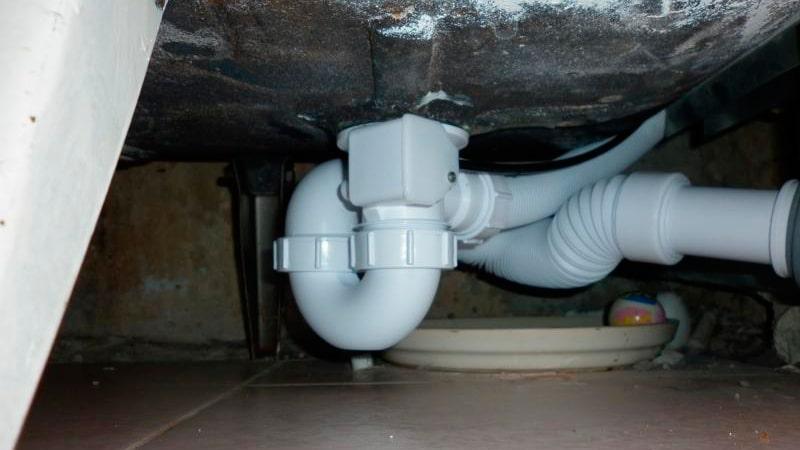
It is not necessary to apply special efforts and use special tools when fixing parts, since the device breaks easily
It is important to consider that the functionality, reliability and durability of the device depends on the correct installation and tightness of all connections.
Rubber gaskets should be purchased separately from the device. The connection of the siphon should be started from the bottom hole.
To avoid stagnation of water in the system, which can cause an unpleasant odor, it is recommended to install the piping above the sewer pipes. The device must be easily accessible so that, in the event of a malfunction, it can be repaired without breaking the tiles or the sealed screen.
High-quality bathroom piping - what we hope you learned with the help of this article. Do not forget that even the most reliable system made of high-strength materials can become clogged, leak or fail if used improperly. Drain-overflow is not a 100% guarantee against water flowing over the edges of the bathtub with strong pressure, so it is necessary to monitor its level when filling.
How to install the strapping or replace it
Installation of a universal type system can be done on its own. It is better to entrust the installation of semi-automatic and automatic systems to professionals.
Before starting work, prepare everything you need:
- drain system;
- hacksaw for metal or grinder;
- screwdriver;
- napkins;
- sealant.
The installation of the strapping consists of several stages.
Removing the spent strapping
Before you start installing a new drain system, you need to clean the entire bath and get rid of the old device.
Elements of the plastic system are easily unscrewed. In special cases, they can simply be broken off. To remove the strapping elements from the metal, you need a grinder.
To dismantle all metal elements, the first step is to remove the drain neck, while trying not to violate the integrity of the enamel coating.
If it is difficult to get to the bottom of the bath, then it is better to turn it over. Soak a cloth in the cleaning solution and remove any dirt.
Installation of drain and overflow necks
Both of these elements are arranged in the same way. There is a faceplate, a neck, a fixing screw and rubber gaskets. We remove all irregularities and burrs from the neck, clean it with sandpaper.
The drain hole must be wiped so that no moisture remains. Then you need to disconnect the grates from the drain and overflow pipes.
We install gaskets in the necks, where they come into contact with the neck, we coat with silicone sealant.
We install the fixing bolt in the center of the lining, install it with the other side into the overflow neck, and then tighten it.
The overflow system is mounted in the same way.
Siphon installation
The siphon consists of two parts that need to be connected.
A plastic nut is installed in the inner part of the small element, a rubber seal is placed under it. The wide part of the seal must be adjacent to the docking place.
The small element is inserted into the large one, after which the nut is tightened. The small element must maintain its mobility along the axis.
Docking parts
To connect the lower part of the drain system and the upper overflow system with the corrugation, nuts are put on the ends of the pipes. In this case, it is necessary to tighten the gaskets that look like a cone. Their thick side should face the nut.
The siphon is connected to the corrugation with an additional cone gasket. It is inserted into the hose and fastened with a nut.
The corrugation is easily stretched, which makes it easy to insert it into the pipe. In some models, the corrugation is connected without nuts. She is simply put on a fitting.
After attaching the siphon to the drain neck, it must be secured with a nut. Do not forget about the gasket.
We twist the siphon until a creak is heard. In order not to damage the parts, do not apply excessive force.
When all the elements are in their proper places, we put the bath in its original position. Now you need to check if everything is assembled correctly.
The floor under the siphon is covered with newspaper and water is supplied. If something is assembled incorrectly, then moisture will be immediately noticeable on the newspaper. If leaks are visible, then you need to tighten the parts of the siphon.
If this does not bring a positive result, then it is necessary to lubricate all structural elements with silicone sealant.
The drain and overflow system is not a panacea. It will not give full confidence that the neighbors will not be flooded by you. Always keep an eye on the amount of water in the bath.
Clean with a mole or other chemical agent.
If you're not into brute force, buy a sewer cleaner from your local hardware store and use it as directed. It is generally believed that cleaning the sewer with chemicals is ineffective, as this destroys the microorganisms involved in the self-cleaning of the sewer, and therefore, after using chemicals, the sewer will clog more often. But for manufacturers of chemical sewer cleaners, this has its own benefits.
ease of operation - very easy
time - 60-90 minutes
costs - $ 1-2
pollution level - minimum
effectiveness - for 1-2 months helps.
What is the harness made of?
The piping system includes holes for drain and overflow. Water is discharged through the drain hole, and the overflow hole allows you to control the water level in the bathroom.The harness is not difficult to install, so it is very often used.
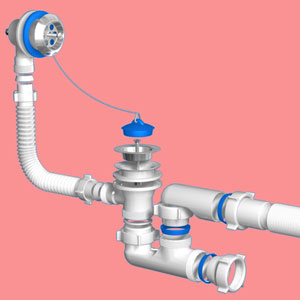
It is immune to the action of chemical reagents, therefore it is widely distributed. But despite its positive qualities, plastic is afraid of mechanical damage, which is a problem during installation.
This is due to the fact that during operation it becomes necessary to cut or build up elements of the plastic structure, as well as the appearance of various notches that need to be cleaned.
Metal straps are no less functional, but they also have their drawbacks. They are quite difficult to install, they have a tendency to pollution. Yes, and they are expensive.
How to install a bathtub trim
Consider how the strapping is installed on the bath. The work is carried out according to the following algorithm:
The old harness is dismantled. If it was plastic, then there are usually no problems with removal. Even if she does not want to unwind, she can be easily broken and removed. Difficulties can arise with a metal strapping, sometimes you have to use a grinder to remove it.
- Now you should check the completeness of the new harness, making sure that all gaskets and other elements are in place.
- Next, you need to disconnect the grates from the drain and overflow pipes.
- It is quite inconvenient to mount the outlet from the bath, since it is located low, and you have to work in an extremely uncomfortable position. To facilitate the task, you can first connect the siphon to the sewerage system, and then put the bathtub. But this method is only suitable for baths made of light materials. When installing a cast-iron bath, it is better not to use the described installation method, since such a heavy model will be difficult to install exactly in the right place the first time.
- On the reverse side of the bath, a receiving pipe is attached, on which a rubber gasket should be put on.
- A grate is installed from the inside of the bath, then the structure is fastened with a coupling bolt. This operation is more convenient to perform with a partner. One will press the outlet pipe to the hole from below, and the second will be able to insert the neck and tighten it.
- When performing work, you do not need to make great physical efforts, otherwise the strapping parts may burst, which will necessitate the purchase of a new part.
- The overflow tube is installed in the same way. It is only necessary to pre-stretch the corrugated tube to the required size so that it enters the nozzle.
- Some models of harnesses are equipped with four rubber gaskets, in this case, they are installed both inside the bathtub and on its reverse side. If there are only two gaskets in the kit, then they should be installed on the back (outer) side of the bath, otherwise, you will have to face the problem of leaks. Additionally, a silicone-based sealant can be used.
So, there are several varieties of drain / overflow systems for bathtubs. If a simple plastic harness is chosen, then it is easy to install it yourself. In the event that a semi-automatic bath piping is purchased, it is better to entrust its installation to specialists, since the installation of such a system is much more difficult.
Strapping options
As already mentioned, the strapping is divided into several types. The classification depends on two parameters: design and material. There are the following types of construction:
- universal type systems;
- semi-automatic systems;
- automatic type systems.
Tying a universal type system
This is the simplest and most common type. It is used in almost any bath: made of acrylic, steel, cast iron.
The main requirement for universal type systems is to maintain the distance from the central part of the overflow hole to the drain hole. It should not be more than 57.5 centimeters.
- Drain hole neck. It includes a metal overlay on which a plug is installed.
- Overflow neck. It also comes with an overlay.
- The most important part of the entire system is the siphon. It ensures that water is drained into the sewer and does not allow sewage odors to enter the rooms. Siphons are collapsible or solid.
- Corrugated hose. With its help, connect the drain and overflow necks. Installation is carried out by putting on the fitting and fastening with union nuts.
There is a grate on the outside of the overflow hole, and a receiving block is connected from the inside. A drain pipe is attached to the receiving block, which is connected to the lower outlet using a pipe.
To drain water in universal systems, there is a plug that is inserted into the drain hole.
There are practically no moving parts in universal harnesses, so they are considered the most practical.
Semi-automatic systems
The design of this type of system includes a rotary lever that allows you to block the drain neck. They are very convenient to use, even if you are lying in the bath. With proper skill, it can even be opened with your toes.
The principle of operation of this system is mechanical. The device starts working when the valve, which is installed on the neck of the overflow hole, moves. The valve is connected with a cable to another lever, which is located in the drain neck.
Rotation allows you to tighten or loosen the cable, which raises or lowers the plug that closes the drain hole.
Automatic type systems
There are no cables or other fragile parts in automatic type systems. Drainage of water is carried out by pressing the plug.
A spring and a retainer are installed under the plug. The spring, when the cork presses on it, pushes the latter out. One more press - and the drain is blocked.
The disadvantage of this system is the small size of the hole through which water flows, which leads to the accumulation of hair, debris.
If the device is of poor quality, then its disadvantage is the possibility of breakage, which is very difficult to fix on your own. The solution to the problem is to completely replace the kit.
The second part of the connection
Installing a siphon to drain water for a sink and bath does not end there, as a number of actions need to be carried out to complete the process.
 A drain should be considered before installing the bathroom itself.
A drain should be considered before installing the bathroom itself.
Namely:
A water seal must be connected to the cavity of the drain neck located under the bathtub. Before connecting, the plumbing element is carefully inspected so that there are no defects, cracks and burrs at the sealing site. They will significantly spoil the strength of the connection. If they are present, they must be cut off with a knife or cut off with a file.
Regardless of which siphon is used, in particular, the type and purpose, the water lock must be connected to the neck cavity precisely by means of a union nut, as well as a flat or cone-shaped gasket.
Then, either a corrugation or a branch pipe is installed on the water lock in order to carry out the installation of the siphon and sewerage.
In the very connection of the siphon to the sewer, you need to pay attention to the fact that there are products that need to be installed directly into the socket cavity of the plastic pipe, and there are those that require an additional sealing cuff. If an old cast-iron sewer is installed in the house, then it will not be possible to do without a cuff.
Regardless of what is being done - replacing or assembling a new drainage system, it is necessary to check the tightness of the coupling of the elements before connecting and after.
As soon as the bath is half filled, you need to open the plug and check the siphon itself and its connections to the sewer. Accordingly, if there is no leak, then the work is done correctly, and if there is, then you need to double-check the tightness and tighten some places.
Varieties of strapping for the bath
Having studied some of the subtleties of the question of what a tub strap is, you can get acquainted with the design features of different models. Three types of products are produced:
- A universal model with a stopper on a chain, designed for any type of bath - acrylic, steel, cast iron. This device, consisting of a siphon, a drain with a metal lining for the lid, an overflow with a lining of the same type and a flexible hose connecting the drain with an overflow pulling on a fitting or using nuts, is simple in design and low cost.
- A semi-automatic device, the characteristic feature of which is a rotary lever, connected with a cork by a cable. Depending on the direction of rotation of this part, the drain opens or closes.
- The automatic bathtub piping is easy to use and has no fragile parts. You can close or open the drain by lightly pressing the plug, which is easy to do even with your heel. Automatic machines are very convenient, in which it is possible to draw water and open the drain in a semi-automatic mode. There is no need to install a mixer with such a drain-overflow system.
Special designs are available for non-standard tubs and custom-made containers.
